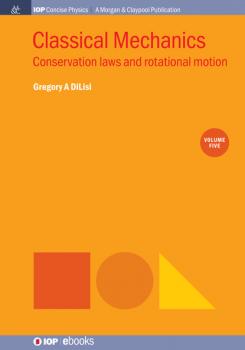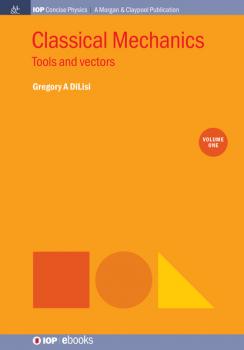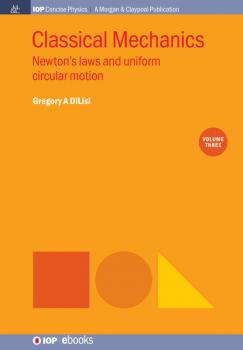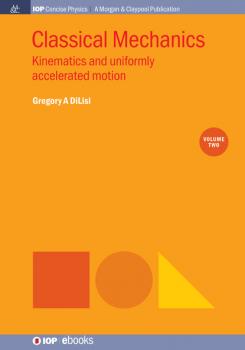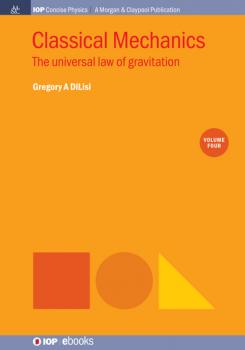ТОП просматриваемых книг сайта:
IOP Concise Physics
Скачать книги из серии IOP Concise PhysicsLasers and Their Application to the Observation of Bose-Einstein Condensates - Richard A Dunlap
IOP Concise PhysicsАннотация
The first part of this book overviews the physics of lasers and describes some of the more common types of lasers and their applications. Applications of lasers include CD/DVD players, laser printers and fiber optic communication devices. Part II of this book describes the phenomenon of Bose-Einstein condensation. The experimental techniques used to create a Bose-Einstein condensate provide an interesting and unconventional application of lasers; that is, the cooling and confinement of a dilute gas at very low temperature.
Аннотация
Classical Mechanics teaches readers how to solve physics problems; in other words, how to put math and physics together to obtain a numerical or algebraic result and then interpret these results physically. These skills are important and will be needed in more advanced science and engineering courses. However, more important than developing problem-solving skills and physical-interpretation skills, the main purpose of this multi-volume series is to survey the basic concepts of classical mechanics and to provide the reader with a solid understanding of the foundational content knowledge of classical mechanics. Classical Mechanics: Conservation Laws and Rotational Motion covers the conservation of energy and the conservation of momentum, which are crucial concepts in any physics course. It also introduces the concepts of center-of-mass and rotational motion.
Аннотация
Vortices comprising swirling motion of matter are observable in classical systems at all scales ranging from atomic size to the scale of galaxies. In quantum mechanical systems, such vortices are robust entities whose behaviours are governed by the strict rules of topology. The physics of quantum vortices is pivotal to basic science of quantum turbulence and high temperature superconductors, and underpins emerging quantum technologies including topological quantum computation. This handbook is aimed at providing a dictionary style portal to the fascinating quantum world of vortices.
Аннотация
Classical Mechanics teaches readers how to solve physics problems; in other words, how to put math and physics together to obtain a numerical or algebraic result and then interpret these results physically. These skills are important and will be needed in more advanced science and engineering courses. However, more important than developing problem-solving skills and physical-interpretation skills, the main purpose of this multi-volume series is to survey the basic concepts of classical mechanics and to provide the reader with a solid understanding of the foundational content knowledge of classical mechanics. Classical Mechanics: Tools and Vectors is simply about transmitting information. The conventions used to transmit certain types of numerical information are crucial concepts that must be addressed at the outset of any series on classical mechanics by discussing scalars versus vectors for example.
Аннотация
Classical Mechanics teaches readers how to solve physics problems; in other words, how to put math and physics together to obtain a numerical or algebraic result and then interpret these results physically. These skills are important and will be needed in more advanced science and engineering courses. However, more important than developing problem-solving skills and physical-interpretation skills, the main purpose of this multi-volume series is to survey the basic concepts of classical mechanics and to provide the reader with a solid understanding of the foundational content knowledge of classical mechanics. Classical Mechanics: Newton's Laws and Uniform Circular Motion focuses on the question: 'Why does an object move?'. To answer that question, we turn to Isaac Newton. The hallmark of any good introductory physics series is its treatment of Newton's laws of motion. These laws are difficult concepts for most readers for a number of reasons: they have a reputation as being difficult concepts; they require the mastery of multiple sub-skills; and problems involving these laws can be cast in a variety of formats.
Аннотация
Classical Mechanics teaches readers how to solve physics problems; in other words, how to put math and physics together to obtain a numerical or algebraic result and then interpret these results physically. These skills are important and will be needed in more advanced science and engineering courses. However, more important than developing problem-solving skills and physical-interpretation skills, the main purpose of this multi-volume series is to survey the basic concepts of classical mechanics and to provide the reader with a solid understanding of the foundational content knowledge of classical mechanics. Classical Mechanics: Kinematics and Uniformly Accelerated Motion focuses on the difference between asking, 'How does an object move?' and 'Why does an object move?'. This distinction requires a paradigm shift in the mind of the reader. Therefore, the reader must train themselves to clarify, 'Am I trying to describe how the object moves or why the object moves?'.
Аннотация
Classical Mechanics teaches readers how to solve physics problems; in other words, how to put math and physics together to obtain a numerical or algebraic result and then interpret these results physically. These skills are important and will be needed in more advanced science and engineering courses. However, more important than developing problem-solving skills and physical-interpretation skills, the main purpose of this multi-volume series is to survey the basic concepts of classical mechanics and to provide the reader with a solid understanding of the foundational content knowledge of classical mechanics. Classical Mechanics: The Universal Law of Gravitation focuses on the notion that forces act through their associated fields, which is first introduced when discussing Newton's universal law of gravitation. A huge conceptual leap is required from the reader: an object can cause another object to move without even touching it. This is a difficult concept to reconcile with our everyday experiences but it makes perfect sense when we realize that is exactly how the Earth acts on us. Gravity is able to pull on us even though we are not in direct contact with the Earth. Also, the concept of super-position (and when it is applicable) is introduced. Super-position is crucial to the development of problem-solving skills so it will be illustrated in a number of example problems.
Аннотация
This book provides an introduction to the emerging field of quantum thermodynamics, with particular focus on its relation to quantum information and its implications for quantum computers and next generation quantum technologies. The text, aimed at graduate level physics students with a working knowledge of quantum mechanics and statistical physics, provides a brief overview of the development of classical thermodynamics and its quantum formulation in Chapter 1. Chapter 2 then explores typical thermodynamic settings, such as cycles and work extraction protocols, when the working material is genuinely quantum. Finally, Chapter 3 explores the thermodynamics of quantum information processing and introduces the reader to some more state of-the-art topics in this exciting and rapidly developing research field.
Аннотация
Maple is a comprehensive symbolic mathematics application which is well suited for demonstrating physical science topics and solving associated problems. Because Maple is such a rich application, it has a somewhat steep learning curve. Most existing texts concentrate on mathematics; the Maple help facility is too detailed and lacks physical science examples, many Maple-related websites are out of date giving readers information on older Maple versions. This book records the author's journey of discovery; he was familiar with SMath but not with Maple and set out to learn the more advanced application. It leads readers through the basic Maple features with physical science worked examples, giving them a firm base on which to build if more complex features interest them.
Аннотация
This book provides an introduction to topological matter with a focus on insulating bulk systems. A number of prerequisite concepts and tools are first laid out, including the notion of symmetry transformations, the band theory of semiconductors and aspects of electronic transport. The main part of the book discusses realistic models for both time-reversal-preserving and -violating topological insulators, as well as their characteristic responses to external perturbations. Special emphasis is given to the study of the anomalous electric, thermal, and thermoelectric transport properties, the theory of orbital magnetisation, and the polar Kerr effect. The topological models studied throughout this book become unified and generalised by means of the tenfold topological-classification framework and the respective systematic construction of topological invariants. This approach is further extended to topological superconductors and topological semimetals. This book covers a wide range of topics and aims at the transparent presentation of the technical aspects involved. For this purpose, homework problems are also provided in dedicated Hands-on sections. Given its structure and the required background level of the reader, this book is particularly recommended for graduate students or researchers who are new to the field.


